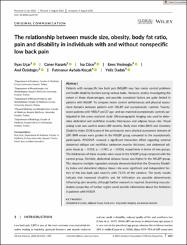| dc.contributor.author | Uçar, İlyas | |
| dc.contributor.author | Karartı, Caner | |
| dc.contributor.author | Cüce, İsa | |
| dc.contributor.author | Veziroğlu, Enes | |
| dc.contributor.author | Özüdoğru, Anıl | |
| dc.contributor.author | Koçak, Fatmanur Aybala | |
| dc.contributor.author | Dadalı, Yeliz | |
| dc.date.accessioned | 2023-06-23T13:28:02Z | |
| dc.date.available | 2023-06-23T13:28:02Z | |
| dc.date.issued | 2021 | en_US |
| dc.identifier.citation | Uçar, İ., Karartı, C., Cüce, İ., Veziroğlu, E., Özüdoğru, A., Koçak, F. A., & Dadalı, Y. (2021). The relationship between muscle size, obesity, body fat ratio, pain and disability in individuals with and without nonspecific low back pain. Clinical Anatomy, 34(8), 1201-1207. | en_US |
| dc.identifier.issn | 08973806 | |
| dc.identifier.uri | https://doi.org/10.1002/ca.23776 | |
| dc.identifier.uri | https://hdl.handle.net/20.500.12513/5185 | |
| dc.description.abstract | Patients with nonspecific low back pain (NSLBP) may face motor control problems and health disability barriers during various tasks. However, studies investigating the extent of these disadvantages, and possible associated factors are quite limited in patients with NSLBP. To compare motor control performances and physical assessment domains between patients with NSLBP and asymptomatic controls. Twenty-seven patients with NSBLP and 27 age- and sex-matched asymptomatic controls participated in this cross-sectional study. Ultrasonographic imaging was used to determine abdominal and multifidus muscles thicknesses and adipose tissue rate. Visual analog scale was used to assess LBP severity. Body mass index (BMI) and Oswestry Disability Index (ODI) scores of the participants were physical assessment domains of LBP. BMI values were greater in the NSLBP group compared to the asymptomatic participants. ANCOVA revealed a significant interaction effect regarding external abdominal oblique and multifidus lumborum muscles thickness, and abdominal adipose tissue (p = 0.015; p = 0.001; p = 0.006), respectively in terms of two groups. The thicknesses of these muscles were lesser in the NSLBP group compared with the control group. Similarly, abdominal adipose tissue was higher in the NSLBP group. The stepwise multiple regression analysis demonstrated that the Oswestry Disability Index and abdominal adipose tissue rate were significant and independent factors of the low back pain severity with 73.5% of the variance. The study results indicate that increased disability and fat infiltration are possible determinants influencing pain severity, although further research is required. Examining musculoskeletal properties of lumbar region could provide information about the limitation in patients with NSBLP. © 2021 American Association of Clinical Anatomists. | en_US |
| dc.language.iso | eng | en_US |
| dc.publisher | John Wiley and Sons Inc | en_US |
| dc.relation.isversionof | 10.1002/ca.23776 | en_US |
| dc.rights | info:eu-repo/semantics/openAccess | en_US |
| dc.subject | abdominal muscles | en_US |
| dc.subject | adipose tissue | en_US |
| dc.subject | back pain | en_US |
| dc.subject | diagnostic imaging | en_US |
| dc.subject | paraspinal muscles | en_US |
| dc.title | The relationship between muscle size, obesity, body fat ratio, pain and disability in individuals with and without nonspecific low back pain | en_US |
| dc.type | article | en_US |
| dc.relation.journal | Clinical Anatomy | en_US |
| dc.contributor.department | Fizik Tedavi ve Rehabilitasyon Yüksekokulu | en_US |
| dc.contributor.authorID | Caner Karartı / 0000-0002-4655-0986 | en_US |
| dc.contributor.authorID | Fatmanur Aybala Koçak / 0000-0002-2224-3324 | en_US |
| dc.identifier.volume | 34 | en_US |
| dc.identifier.issue | 8 | en_US |
| dc.identifier.startpage | 1201 | en_US |
| dc.identifier.endpage | 1207 | en_US |
| dc.relation.publicationcategory | Makale - Uluslararası Hakemli Dergi - Kurum Öğretim Elemanı | en_US |


















